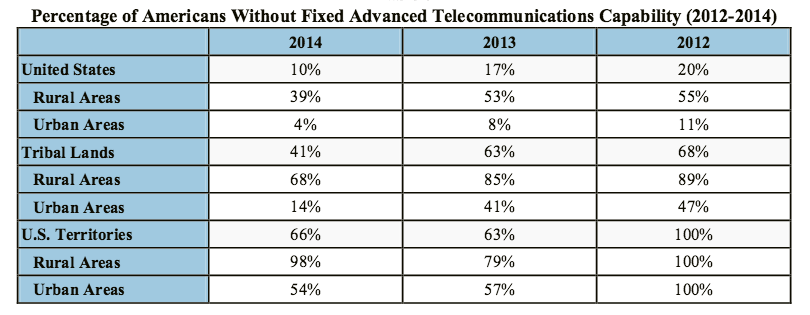For years, my family home in Jaffrey, N.H., located in a rural part of the Granite State, lacked any options for broadband Internet access.
That's not a huge surprise, given that our house sits on a dirt road 10 minutes from the nearest gas station/convenience store (which also sells bait) and maybe 20 minutes from a supermarket. The lack of Internet was annoying, and making do with dial-up brought back memories from the early 1990s, when downloading a picture played out like the slow reveal of a prize on a game show.
Our situation changed a few years ago, when a minor Internet provider moved into the area and offered us service. It's probably closer to the old 4Mbps standard than the new 25Mbps download/3Mbps upload that the Federal Communications Commission now requires to be defined as broadband, but it's good enough to at least stream video acceptably.
It turns out that we were lucky, as the latest progress report shows that a surprising amount of Americans still lack broadband service even when the old standard is applied.
What the report says
The FCC report didn't mince any words about how it feels the Internet industry has performed when it comes to delivering "advanced telecommunications capability" to all Americans and to determine whether such capability is being deployed in a timely fashion.
"We find that advanced telecommunications capability is not being deployed to all Americans in a reasonable and timely fashion," the report said. "[W]hile our efforts have helped increase deployment, many Americans still lack access to advanced telecommunications capability, especially in rural areas and on tribal lands. The disparity between advanced telecommunications capabilities available to rural and urban Americans persists."
In numerical terms, 6% of Americans lack access to fixed terrestrial Internet service at 10Mbps download/1Mbps upload and 5% lack access to such services at 4Mbps/1Mbps. Roughly, that's 19.9 million Americans who can't buy wired broadband of at least 10Mbps/1Mbps and 16.1 million Americans who can't purchase wired broadband of at least 4Mbps/1Mbps. When you apply the new 25Mbps/3Mbps standard, the number jumps to 34 million, or about 10% of the country.
The FCC reiterated in the report that it believes the 25/3 standard is the minimum for what can be considered broadband.
"We conclude that 25 Mbps/3 Mbps continues to provide consumers with the capacity necessary to utilize 'advanced' services that enable users to originate and receive high-quality voice, data, graphics, and video telecommunications," the report stated.

Source: FCC.
What the industry says
The National Cable & Telecommunications Association, which represents all the major cable companies including Comcast (CMCSA +0.01%), the biggest pure cable provider, and Charter Communications, which will become No. 2 assuming its deals to buy Time Warner Cable (NYSE: TWC), and Bright House receive FCC approval, has been an outspoken critic of the federal agency's report.
"Despite the significant, year-over-year advances in broadband capabilities underscored in the commission's own data, the conclusions of the FCC's 706 Report continue an alarming trend of ignoring objectivity and facts in order to serve political ends and maximize agency power," the NCTA said in a statement. "Once again, the FCC arbitrarily defines 'broadband' as requiring a 25 Mbps connection (notwithstanding its lower 10Mbps standard used when doling out universal service support), and in so doing, diminishes the report's value and chooses expediency over honest assessment."
When the 25/3 standard was being considered, Comcast argued against it by telling the FCC that a "4Mbps connection has been found to be sufficient to handle streaming HD video," ARS Technica reported, while at the same time telling customers on its website that with 150Mbps, they can "game in real time, and stream HD movies."
Time Warner Cable was guilty of making a similar argument, according to FCC Chairman Tom Wheeler, ARS reported. The company came out against the higher standard while promoting this:
[B]etween laptop, tablets, and smartphones you'll need all the bandwidth you can get. 15Mbps works for two adults with two smartphones. 20Mbps: one person with a smartphone, a TV and a video streaming device. 30Mbps: a family, two adults, two kids, two TVs, one tablet, two computers, and one on-demand device.
Clearly, the industry wants the FCC to define broadband one way and consumers to look at it another way entirely.
It's a bit of both
Comcast, Time Warner Cable, and the NCTA are right in both arguments. I can muddle through in New Hampshire using our sub-par broadband-ish connection. I can work, stream video, and do most things when using a single computer, but get other people in the household using the Internet, and performance degrades quickly.
The FCC is right to push for a higher standard, and the industry has a point when it mentions how much progress has been made and notes that the FCC has essentially raised the bar in the middle of the marking period. Still, however broadband is defined, now it's clear that going forward people will need faster speeds to accommodate increasing demand.
This report shows that some Americans are under-served and some are not served at all. That needs to change, and Comcast, Time Warner, and the rest must keep working toward 100% coverage at the higher 25/3 standard.